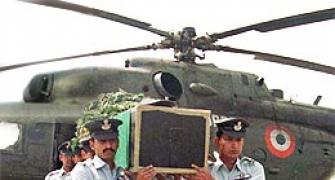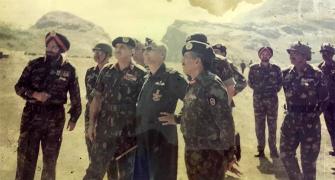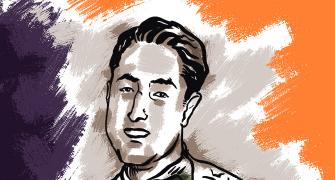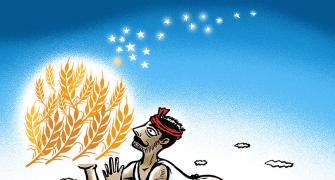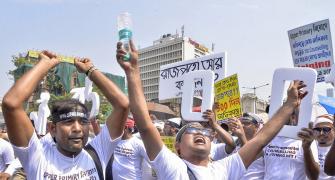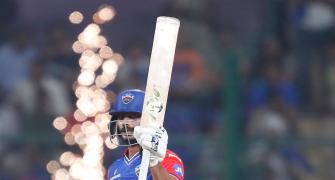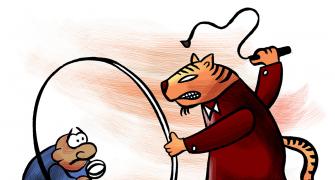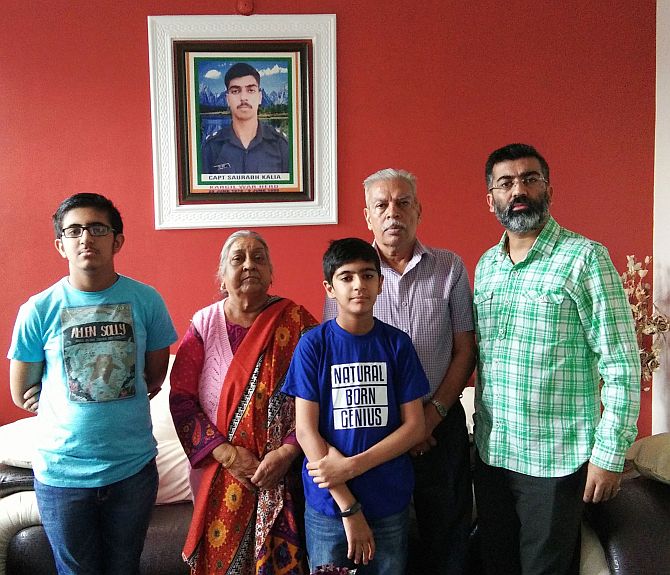Twenty one years ago, the Indian Army and Indian Air Force fought a bloody and bitter war to evict Pakistani intruders from the icy heights in Kargil.
Air Commodore Nitin Sathe (retd) salutes the lesser known heroes of the Kargil War.
A new series.
- Part 1: Colonel Gautam Khot (retd), Vir Chakra: 'The enemy started firing at us'
- Part 2: Group Captain Ashwani Bhakoo (retd), VSM: 'The Pakistanis had state of the art anti-aircraft missiles to shoot us down'
Group Captain Alok Chauhan (retd)
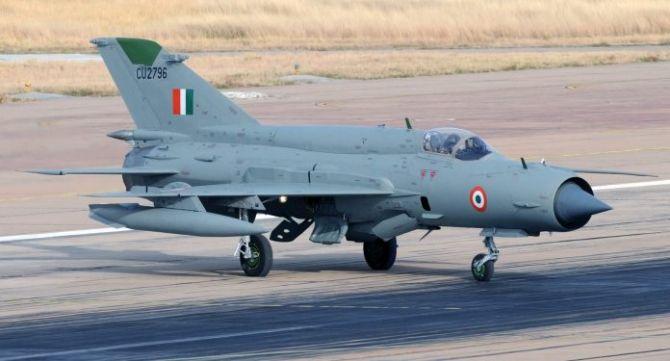
Group Captain Alok Chauhan is a thoroughbred MiG-21 pilot.
For those of you who don't know, the MiG-21 is an unforgiving machine and requires the best of the best to fly it, especially in combat.
And the MiG-21 guys are seen as the most rugged and macho pilots who are fun loving on the ground and ruthless in the air.
And that's what Squadron Leader Alok Chauhan was when he was posted to the prestigious 51 Squadron located at Srinagar in the time of the Kargil War.
His squadron was training alongside 17 Sqn at Bhatinda (commanded by then Wing Commander Birender Singh Dhanoa who went on to become the chief of the air staff) during 1999 and were expected to stay there till the end of May.
However, on 15th May, orders were received to move back to base the very next day.
"We had a whiff of some trouble brewing, but weren't expecting such a fast move," remembers Alok who today flies the Airbus for a commercial airline.
"Srinagar runway had been under repair and we had been operating from the nearby satellite base of Awantipora for some time before we left for Bhatinda. So it was good to be back at home base after long," says the veteran of many thousand hours of flying.

Srinagar airfield was abuzz with activity when they landed and it was known that there would be action soon and the overall mood was electric.
Transport aircraft were parked at all corners of the airfield and vehicles of all hues criss-crossed over the tarmac carrying loads and people in combat fatigues.
This included rations, weapons and armament of all types.
'The MiG-23s and MiG-27s had also arrived at base and so had some MiG-29s at Awantipora. Dhanoa sir's squadron followed us to Srinagar in a couple of days and there was a literal mela at the airfield," remembers Alok, then the deputy flight commander of the squadron.
Friends and course mates from different squadrons interacted with each other and spoke of nothing but firing and combat.
Alok was super excited talking to me about the war that he took part in and the experiences of 1999 that have been etched permanently in his memory.
His adrenalin showed up as he spoke; it was as if he had just landed after a live mission.
"No one knew what the real story was and no one was asking anyone. Orders were passed down and aircraft and armament stores prepared without questions asked. In this 'fog of war' I was looking for clarity of where we were supposed to be heading, what and who was the enemy we had to engage and in what timeframe were we supposed to be ready," recalls the then deputy flight commander who wanted to make sure his boys were well briefed and ready with their maps, plans and tactics.
The media had arrived almost along with the fighting forces and were trying their best to get their bytes of info.
Thanks to the allowed coverage, this was the first time that Indians saw a war unfolding before their eyes in their living rooms.

In a day or two, briefings were carried out and things were getting clearer.
"The role of my squadron was to provide for Air Defence Escorts to the strike formations," says Alok.
The IAF had not fired weapons at high altitudes. Also, the Russian manuals had no data of what were the ballistic figures for heights above 2.5 km (8,500 feet).
"All targets in the area were above 14,000 to 15,000 feet and above and therefore we had to get on to the drawing board.
"Parameters of height, speed, dive angles, time of flight of weapon etc are worked out by the manufacturer and given out in flight/weapon manuals.
"These are used by the pilots to deliver the weapons accurately.
"Tony sir (Dhanoa) and our squadron chaps worked round the clock and applied all the knowledge of weapon delivery and physics that they knew and came up with fresh firing parameters for the heights we were expected to fire from.
"The data from the manuals cannot be simply extrapolated from the figures available and we had to lagao our own theta," remembers the veteran with a smile.
A few quick dummy sorties were flown over Srinagar and some of the pilots were given a chance to try their hand at firing at the high altitude range of Tosha Maidan due west of the airfield.
"By and large, the weapons were hitting the targets and we were happy with our handiwork. Most of the guys had to learn on the job while doing actual missions," he adds.
"The GPS (Global Positioning System) was new to us and we had to learn how to use the hand held ones we were asked to share with 9 Squadron.
"So I sent a few youngsters on their bikes to navigate from point to point within the airfield with the sets to learn about the nuances of operating this very important piece of equipment which would take us and our weapons to the target without fail.
"The aircraft of 17 Squadron had integral GPS sets fitted and we had been envying them since they did not have to do real map reading like the rest of us!"
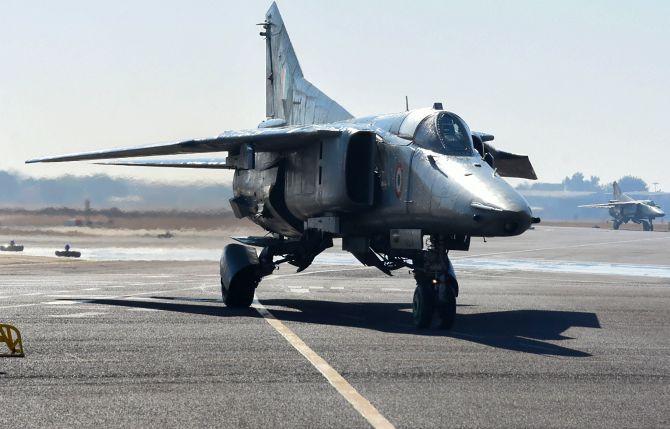
"Use of map references were also a problem area when it came to communicating with the men in green who were fighting on the ground.
"While the army used the age-old system of 'Grid Reference', the air force used 'Coordinates' under the WGS-84 scheme (the US standard department of defence global reference system used for the GPS) adopted by all other air forces.
"This meant that we had to do a lot of minute map reading on the map references of targets given by the army; plot it on our maps and then decipher and feed it on our own systems.
"It was painful for the first few days, but we learnt on the go and so did the army.
"Our job was to go along with the strike aircraft like the MiG-23s and MiG-27s who were armed with bombs and rockets and provide them air defence cover in their immediate vicinity.
"The MiG-29 provided us an additional bubble of cover since they had more potent fire power and stand-off ranges.
"Another set of MiG-29s and Mirage 2000s would set up a combat air patrol just ahead and above the formation.
"17 Squadron had photo recce aircraft who would follow the strike and take photographs for bomb damage assessment.
"So to deliver a few 500 kg bombs and some rockets on to the target, we needed a package of another 8 to 10 aircraft.
"We realised how important each of these had to play as we fought the war.
"In the next few days, we were to come face to face with losing aircraft and our friends to enemy fire.
"It was a harsh way to learn and learn we did -- for our own survival and the detriment of the enemy.
"In anticipation of the live mission coming up, our hearts thumped, adrenalin was in full flow, and we were behaving like the heroes in Hindi movies who were capable of sorting out the bad boys singlehandedly.
"Our hearts missed a beat or two and we got into our cockpits with prayers on our lips and determination to destroy the enemy as our resolve.
"Our first live mission was about to begin.
***
And what a mission it was!
We were wearing our overalls and special flying clothing for high altitudes and carrying our weapons too along with some Pakistani currency notes which could be used if we had to eject behind enemy lines.
Anything was possible, and we were prepared for the worst.
Alok, with his No 2, were to escort these four aircraft and give them protection in the air from enemy air action.
Of the four strike aircraft, two were to drop 4 bombs of 500 kgs while the other two were to strafe the target with rockets and their guns.
Flight Lieutenant K Nachiketa was the fourth in the formation, doing the rocket/gun attack.
Squadron Leader Ajay Ahuja led the two aircraft formation who were to trail the strike by about 10 minutes and do the assessment of the battle damage by filming the area.
Some helicopters were on standby for casualty evacuation at a nearby helipad should a contingency arise.
"It was an intense morning and tensions were running high.
"We were going to go 'Live', and it was a first for most of us. Our tough training at the academy, our flying training and experience was now going to combine into one and we were expected to 'deliver as briefed'.
"High intensity training in realistic situations/conditions is a must to cater for degradation/drop in performance of the man behind the machine.
"This man also has to milk the potential of the machine to the maximum when faced with real life, life threatening situations.
"The degree of degradation can be different in differing situations and has to be catered for.
"As they got used to flying more operational missions in the days ahead, this combat degradation had come down by many a notches.
"However, this was the first mission....
"The mission got airborne as planned. The first two MiG-27s let their bombs off and returned to base.
"From that height, one could see small mushroom clouds of dust rising from where they impacted.
"Bombs were on target!
"One can only imagine how it is at the receiving end of the bomb.
"The sound is deafening, splinters and rocks fly like missiles and the blast sucks in the air around asphyxiating everyone.
"The shock waves can be felt for miles around.
It was time for Nachiketa and his leader, Mando, to let go of their rockets.
Rockets have to be aimed and fired at the target from closer range.
Unfortunately, Mando could not see the target as he got into the dive and aborted.
Nachi was following and he made contact and let go of his weapon load and turned around for another pass.
'Confirm contact with target, look for my weapon impact,' Nachi radioed Mando.
Mando replied in the affirmative and followed Nachi who was going in for his second pass.
Mando let go of his rockets and Nachi came in for one final pass over the target with his front guns, asking Mando to follow him.
Suddenly, the radio crackled, 'I have an engine failure, attempting relight...' said Nachi, his voice calm as a cucumber.
He had turned away from the target and gained height with extra speed.
Mando followed him, trying to see if he would come out of the situation.
'No joy, EJECTING!' boomed Nachi's voice over the radio.
The next minute, Mando saw the aircraft go into a rapid descent and crash into a plume of dust and flame.
He could not see any parachute deploying and thought that the worst had happened.
Nachi had gone down with the airplane.
After a few more orbits to look for his buddy and low on fuel, he set course for Srinagar with a prayer on his lips.
In the words of the Escort leader, "We had set up orbit over the MiG-27s as they went about their business.
"The terrain was so jagged and undulating below, and I was wondering how the guys were even seeing the target in the first place.
"We were flying well above the envelope of the shoulder fired missiles, but these guys were definitely within range.
"There seemed to be no enemy air activity in the vicinity, and therefore we were safe from above at least.
"Before Nachi went down, I had seen a few plumes of smoke emanating from the ground that appeared to be shoulder fired missiles.
"I warned about the same to the aircraft below.
"In fact, some of those projectiles came up right till our heights -- probably, the manufacturers had not calculated that it would travel much higher in the rarefied atmosphere.
"Later, when the historians wrote about the conflict, I read that as many as 38 missiles were fired at us on Day One of the war."
The escort formation was also low on fuel now and returned to Srinagar.
"On the way back, we got in touch with Squadron Leader Ajay Ahuja, the formation leader of themission call-sign Hercules." Ajay was an accomplished pilot and the flight commander of 17 Squadron.
Displaying the highest qualities of leadership, he had put himself as the mission leader for the first mission from his squadron.
"We landed at Srinagar and there was general confusion as to who had gone down.
"I tried to explain and tell base that I had seen Hyena-2 crash and crossed Hercules formation on way back.
"I was wrong there. Hercules-1 also had crashed in the intervening period. I dashed to the ops room after landing to check.
"News was filtering in that Ajay had ejected and his parachute had been seen.
"I hoped he was on our side of the border and would be picked up by the chopper soon enough.
"I hoped that Nachi too had survived and possibly we hadn't seen his chute deploy.
"By the evening the news had been received.
"Nachiketa had been taken as POW and would return after a few weeks in captivity.
"He had been captured after landing by a captain of the Pakistan army who had prevented his men from bludgeoning him to death.
"He had actually fired from his pistol when they surrounded him and could have been shot by the Pakis, but, thankfully, they let him be.
"As soon as his nine rounds of the Makarov pistol were exhausted, they overpowered him and took him into captivity.
"What happened to him is another story, which, maybe, Nachi may tell after a few years.
"After his filming run, Ajay decided to orbit around the crash site to look for Nachi.
"He orbited there long enough and drifted down to get a better look.
"At this point in time, a shoulder fired missile was fired at his aircraft which, most probably, damaged his jet-pipe leading to reduction of thrust.
"He gave a call that his engine had lost power and before he ejected, he gave the coordinates of where he was ejecting so that it would be easy for the chopper to pick him up.
"He pulled his ejection handle and he was out of the sick aircraft in a flash.
"Soon his chute deployed and he came drifting down, unfortunately falling on to the enemy side.
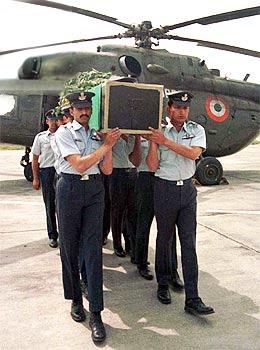
Ajay wasn't so lucky.
As he descended into enemy territory, he was fired upon in all probability.
It is said that he started firing at the enemy well before he touched the ground.
When his body arrived in Srinagar later, all those who saw him saw that he had been fired upon from close quarters -- he had one bullet through his heart and one through his temple, meaning that he had been killed after landing safely on the ground.
It is against the Geneva Convention and not fair to shoot a pilot coming down on his parachute, but then, who said war is fair?
In fact, the Pakistan army captain, who had saved Nachiketa from certain death, was later killed in one of our bombings a few days later.
The air force was just about getting out of the shock of losing two aircraft on the first day of the war.
Just a couple of days later, an Mi-17 helicopter piloted by Squadron Leader Pundir and Flight Lieutenant Muhilan was shot down in the same area.
After the three crashes, and the loss of five lives -- Ajay and the four crew members of the Mi-17 -- the IAF learnt valuable lessons on fighting in high altitude terrain against a well entrenched enemy.
The war continued for the next few weeks and the guns finally fell silent on the 26th of July 1999.

Did you think the war would escalate, I asked Alok.
"We were fighting a war with a well entrenched enemy and it was going to be difficult to evict them from the vantage positions that they had taken over.
"So the feeling that we had was that it would be a long drawn battle; and therefore, the chances were that it would escalate since the enemy would probably draw us into battle in other sectors so as to ease the pressure up north.
"We had to exercise extreme restraint to ensure that we did not cross the LOC and cause embarrassment to our government.
"The logistical issues were really huge.
"Our transport planes flew day in and day out to get in the armaments which we would expend as soon as it was unpacked and make ready for use.
"Kudos to the technical staff and the test pilots who worked ceaselessly while we fought the battle.
"With the passage of time the IAF has done a rethink of how it will fight in the mountains, something that you have seen in the recent flare-up with the Chinese."

"In my opinion, a conventional war is almost impossible today and we have to prepare for high intensity, high tempo, operations in localised areas from now on.
"For this, we have to optimise our weaponry and equipment as also our tactics.
"The use of high end technology and the ability to strike with precision is the name of the game.
"Last, but not the least, synergy between the three services needs to improve; we need to fight together as one unit and speak the same language.
"We also need to become more pro-active rather than reactive in our approach to fighting.
"These aspects have been improving, but, we still have a long way to go.
"And yes, we need to have our diplomacy tuned up to search for solutions before things go the military way."
Air Commodore Nitin Sathe retired from the Indian Air Force in February 2020 after 35 distinguished years of service in the IAF.
He is the author of three books including Tsunami 2004: The IAF Story: a Few Good Men & the Angry Sea about how the IAF rebuilt its Car Nicobar airbase after the December 26, 2004 tsunami completely devastated it.
Feature Production: Aslam Hunani/Rediff.com

